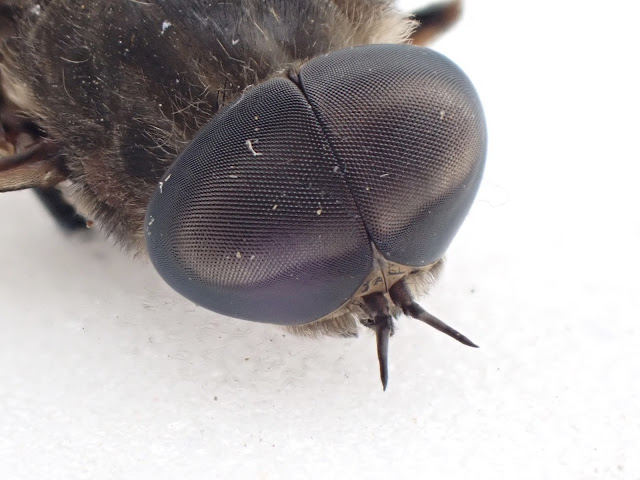Given the warm temperatures yesterday I decided to work in the kitchen with the patio doors open. This means that the odd fly or other insect ends up trapped inside bashing its head on various panes of glass both upstairs and down.
Whilst going up to bed I noticed a large fly sat on a small bit of glass in our front door and potted it, in its lethargy, for a closer look. It was obviously a Tabanus horsefly which I've never seen in the garden before.
Having the rather lovely Stubbs and Drake meant that I could key it too. First bit deals with the head end, to work out whether it's a male or female. Male eyes join at the top of the head but females have a gap.
No doubt at all that I have a male here, eyes very obviously joined. The next couplet deals with wing length. Is it more or less than 13mm? This individual has wings of 16mm, so it's one of the 'large' species of Tabanus.
The next bit is a mix of stuff. Antennae black and top of abdomen without a pattern of pale spots OR antennae usually dull orange but if black then there are sub-lateral spots on the abdomen.
Well the antennae look dark with slightly lighter patches in places but the abdomen patterning definitely put it is in the second choice of the couplet as there obvious sub-lateral spots.
Next we have to look at the eyes. Are all the eye facets the same size or they bigger in the upper half and smaller in the lower half.
You can see here that there are a patch of large facets that appear lighter in the image above, and the smaller, lower facets appear darker. That gets us to two species either Tabanus sudeticus or T. autumnalis, and the patterning of gray triangles down the middle of the abdomen flanked by orangey spots perfectly matches T. autumnalis. This one is also known as the Large Marsh Horsefly and is fairly widespread but most records come south of the Wash-Severn line. I have seen this one before but it's the first record for the garden and another foray into flies...
...and here's the unseasonal post title inspiration. Although the nights are now drawing in. Eek!






















